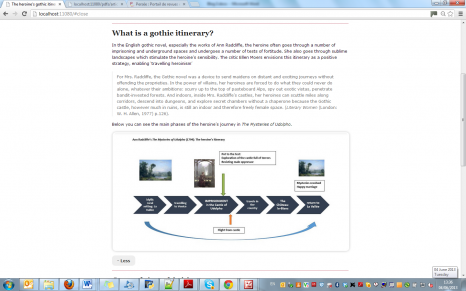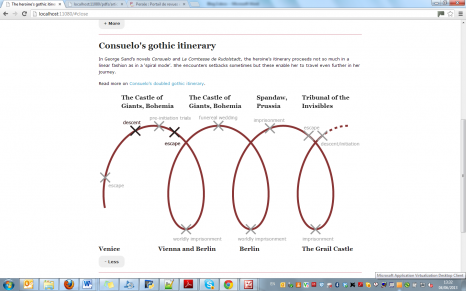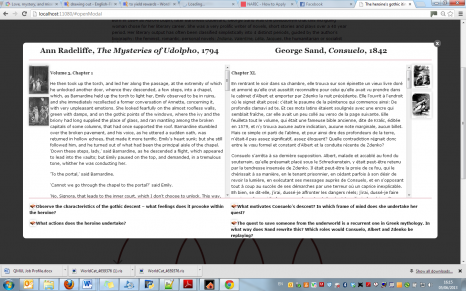sotonDH Small Grants: Visualising intertextual dimensions of the Gothic itinerary in George Sand’s Consuelo and La Comtesse de Rudolstadt – Post 3
November 18, 2013
by Marilyn Mallia
sotonDH Small Grants: Visualising intertextual dimensions of the Gothic itinerary in George Sand’s Consuelo (1842) and La Comtesse de Rudolstadt (1843) – Post 3 by Marilyn Mallia and Neville Grech The final product The home page In order to enable the general user to follow and understand our main section of Consuelo’s gothic itinerary, we provided further contextualisation through the addition of other sections leading …
sotonDH Small Grants: Visualising intertextual dimensions of the Gothic itinerary in George Sand’s Consuelo (1842) and La Comtesse de Rudolstadt (1843) – Post 3 by Marilyn Mallia and Neville Grech
The final product

The home page
In order to enable the general user to follow and understand our main section of Consuelo’s gothic itinerary, we provided further contextualisation through the addition of other sections leading up to our original contribution. Besides the originally planned spiral, we therefore included a section on French author George Sand, one on the gothic itinerary and a final section ‘About’ to explain the rationale of this visualisation tool. These sections appear in their abridged form and can be extended at will.

The section on the gothic itinerary also exploits visualisation opportunities through a linear timeline of the heroine’s steps of progression in Radcliffe’s The Mysteries of Udolpho (1794).The doubling of steps is indicated at first glance through the use of the framing picture of a utopian setting and the arrow indicating a return to the place of origin.
The Spiral
In the course of building this tool, we became aware of the shortcomings of a vertical spiral as visual model. Though more consonant with gothic ideas of descent into the abyss and resembling the well into which Consuelo descends during the key gothic sequence, a downward spiralling suggests regression rather than progression. Also the viewer would have to scroll down to see the different steps, thus losing sight of the itinerary in its entirety. The solution was therefore to change it into a horizontal spiral, moving from left to right in accordance to normal patterns of readership.

We also decided to indicate the two active links through colour, by changing the non-functioning links into grey. The final dots of the itinerary indicate the on-going nature of the itinerary, since the heroine keeps on developing.
The Steps of the itinerary – escape and descent
Upon clicking on the steps ‘escape’ or ‘descent’ in the location ‘The Castle of Giants, Bohemia’, you are taken to the screen below, which juxtaposes the English Gothic on the left with George Sand’s rewriting of it in Consuelo on the right. The user can consult contemporary illustrations of these novels, and while scrolling, reader prompts guide him/her and indicate useful scholarly articles which are open access.

You can try out the tool online on www.gothicconsuelo.appspot.com
Technical Considerations
From a technological point of view, this project is rather conservative. Standard web development techniques were utilised, and the user experience together with the requirements at hand drove the development. We can claim that client side rendering techniques using JavaScript and JQuery were exploited to their fullest. For example, the spiral component is generated each time as the page is rendered and is fully parametric, which means it can be reused to describe other “itineraries” of various lengths. For this, we used an HTML5 canvas, and therefore no client side plugins need to be installed. This, together with other HTML5 features we used, however, requires the user to have a modern browser installed.
There is a lot of scope for further work. One way this project could be extended is to extend it with the content for all parts of the itinerary. Furthermore, an automated method with which links between texts are found could be possibly found using state of the art information retrieval techniques. For example, a user can select two texts of his own choice. which would be annotated with metadata. Information retrieval and natural language processing algorithms can then be used to automatically explore the links between these texts. Unfortunately, the technology is still far behind and one wouldn’t expect the same results as those by a human expert with domain expertise in the field.
Categories: Uncategorized. Tags: Small Grants and WSI.
